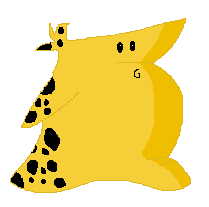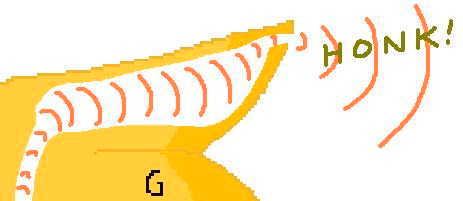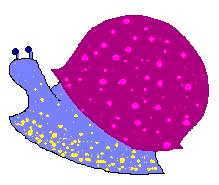
Balotan Herbivores
Cheatler (5)
The Cheatler is a small, herbivorous mammal of Balota. It is approximately half a meter tall, with short yellow fur. Its two arms have no internal bone structure; instead, they are composed mostly of very strong, flexible muscles, creating a stretchy, partially retractable, prehensile limb used for simple manipulation of objects (6). The following are examples of a Cheatler with arms at rest and a Cheatler foraging:

The Cheatler
(for more information on the Cheatler's distant relatives, go to www.homestarrunner.com/)

The Cheatler foraging with its prehensile limb
The Cheatler gets around by means of a single large foot, slightly wider than the rest of its body. The foot features hundreds of incredibly strong muscles, moving in a snail-like motion (7). However, the Cheatler does not employ mucous to protect its foot - the foot is completely dry, with thick callouses, like an elephant's (8). This foot can move over a wide variety of terrains. The Cheatler can even climb fairly steep inclines when it uses its arms for balance and pulling power. The Cheatler seems to be the first to have evoled such a method of locomotion, having diverged evolutionarily from other mammals several hundred thousand years ago. All other native animal species use some variation of this first wide, flat, toeless foot.
The Cheatler eats primarily Thrumblers and other grassy plants. Its teeth are large and blunt for this purpose. During dry weather, Cheatler herds migrate to wetter climes. Cheatlers move in small social groups of 5-15 individuals; herd behavior provides protection and social interaction. Cheatlers have distinct voices and a variety of calls. They produce these impressive noises with the large nasal cavities on the tops of their heads (9). The call of the Cheatler is truly a majestic sound (10).

The Cheatler's large nasal cavity, used for vocalization
The Carapler is one of the more common insect species on Balota. The average Carapler is from 3 to 10 centimeters long. It feeds mostly on Thrumblers and other grassy plant life. It uses its hard exoskeleton for, among other things, protection from the Tootler. When chewed, the Carapler's exoskeleton shatters into sharp, pointy shards. The Tootler has a sensitive tongue and will only eat Caraplers when all other food sources are depleted. The Sneakler, however, does not mind eating sharp food. The Sneakler is the Carapler's primary predator.

The Carapler
The Sloogler is a parasitic snail-like animal that feeds primarily on Pillarilers and Nomadlers. Though the Pillariler's spines and the Nomadler's new acid kill unwary Slooglers, individuals that locate hosts with widely-spaced spines or non-acidic flesh flourish, stealing enough water to survive comfortably, but usually not enough to kill the host. Only infestations of 50 or more Slooglers can kill an otherwise healthy plant. If a Sloogler-infested Nomadler gets caught deep in a dry zone, it may die, leaving the Slooglers enough water and nutrients to last until the next wet season.

The Sloogler